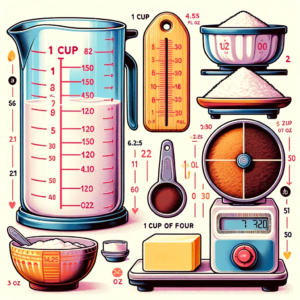When it comes to cooking and baking, understanding measurements is crucial for achieving the perfect outcome. One common question that arises is: How many ounces are in a cup? This is a fundamental concept in kitchen measurements, especially when dealing with recipes that require precise quantities.
In the United States, a standard cup measurement is considered to be 8 fluid ounces. It’s important to note that this is a measure of volume and not weight. Fluid ounces are used to measure the volume of liquids, which can vary in weight. For example, the weight of one cup of water (which is 8 fluid ounces) will be different from that of one cup of honey, even though both occupy the same volume.
To make things a bit more complex, when it comes to dry ingredients, the weight can vary significantly. For instance, a cup of all-purpose flour typically weighs around 4.25 ounces, but this can change depending on the flour type and how it’s measured (sifted, spooned, or scooped).
It’s also worth mentioning that the cup measurement used in the United States differs from the one used in other countries. For example, in the UK, one cup is equal to 10 imperial fluid ounces, which is approximately 284 milliliters, slightly more than the US cup.
In summary, when a recipe calls for a cup in the US, it’s generally referring to 8 fluid ounces. However, remember that this measure of volume does not directly translate to weight, especially for dry ingredients. For accuracy in recipes, especially when baking, it’s often recommended to use a kitchen scale for measuring ingredients by weight.
Understanding these measurement conversions is key to successful cooking and baking, ensuring that your dishes turn out just as the recipe intended.
Let’s explore this with visual aids and more examples to make it as clear as possible.
1. Liquid Measurements:
- In the U.S., a standard cup for liquid ingredients, like water or milk, is equal to 8 fluid ounces.
- Remember, fluid ounces measure volume, not weight. So, 8 fluid ounces of honey will weigh more than 8 fluid ounces of water, even though the volume is the same.
2. Dry Ingredients:
- The weight of dry ingredients in a cup varies. For example, a cup of all-purpose flour typically weighs about 4.25 ounces.
- It’s important to note that different ingredients and even different types of the same ingredient (like sifted vs. unsifted flour) can have different weights in the same volume.
3. Measurement Conversions:
- The U.S. cup (8 fluid ounces) differs from the UK cup (10 imperial fluid ounces).
- For baking, precision matters. Using a kitchen scale can help ensure accuracy.
4. More Examples:
- Sugar and Butter: 1 cup of granulated sugar weighs about 7 ounces, while 1 cup of butter weighs 8 ounces (which is also one standard stick of butter).
- Cocoa Powder: 1 cup of cocoa powder is around 3.5 ounces.


